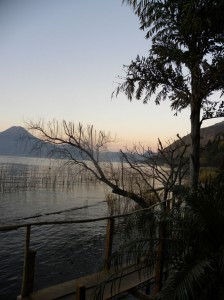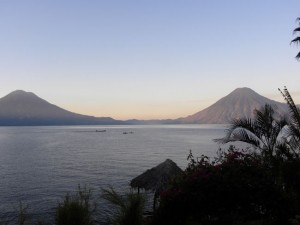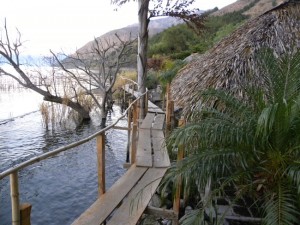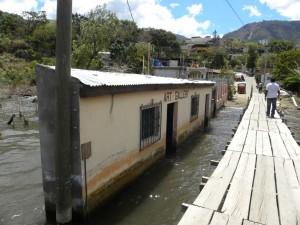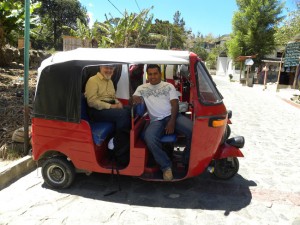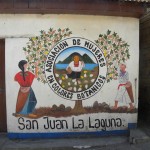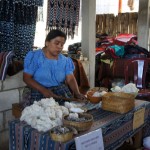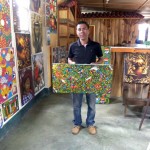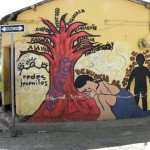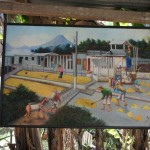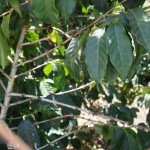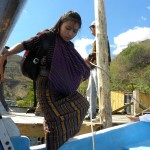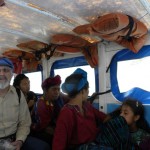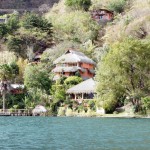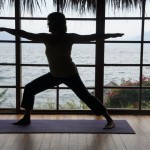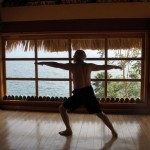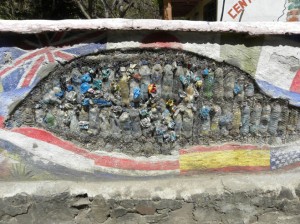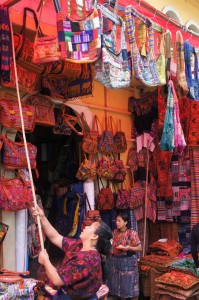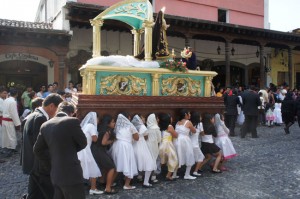Lake Atitlan, Chichicastenango, and Antigua: Dreams and Realities
Lake Atitlan is one of the most beautiful lakes in the world. It has two volcanoes perfectly situated to create a picturesque or even sublime appearance (ie, the difference between simply attractive and actually uplifting, according to 18th century English categories of landscape.)
Naturally a beautiful place like this attracts a lot of people who like beauty in the traditional sense of the word. It is kind of like the National Parks in the US, chosen for their spectacular features, like Yosemite, Yellowstone and Glacier. It makes many people happy to see this view.
But of course, that is not my particular obsession as the author of this art and politics blog. I have to look under the surface of the beautiful and see what is really there.First of all as we arrived to take the boat to our beautiful Villa Sumaya yoga retreat location we saw raw sewage running into the lake at the boat dock! Wow.
Then we learned that the lake had pollution problems: algae blooms shore to shore last year was one big problem. Also in the last year the lake water level rose dramatically flooding out houses on the shore. It is not clear whether this was simply caused by larger than usual rainfalls or blocked exits to the lake, or cosmic energy (apparently the lake is an energy nexus). But the result was a lot of people lost a lot of property into the lake.
But aside from these ecological issues, the human ecology was provocative as well. There were many gringos living along the shore ( many healers tapping into the cosmic energy, as well as hippies from the last century still there). During the Civil War the communities around the lake were decimated, almost all the men were killed. It was a dire situation, perhaps the reason why I still felt a sense of heavy sadness in the spirit of these people.
And of course poverty. The Maya mostly lived up higher on the hills surrounding the lake. The shore is the lusher area, obviously more accessible and inviting. Further up the land is really steep and dry and inhospitable, but it is there that Maya are trying to farm. We didn’t see a lot of terracing, but we did see fields planted and growing. There were exceptions to this struggling life though.
We visited San Juan La Laguna, a dymanic, proud and very clean community along the lake. It had an art cooperative, murals on many walls along the street, a women’s textile cooperative using only botanical dies to create amazing fabrics, a coffee cooperative producing shade grown coffee that is very sweet because it is grown in lower elevations (up higher the coffee gets more acid). There was a medicinal plant center, and a thriving school. We saw a center for women who are victims of violence. We took a little Tut Tut around that was really fun, with an educated driver who said he was a software engineer making a little extra money.
So that was all positive.
There are more pictures on my flikr site. and here.
But then as we went around on the public boat we saw very very young girls with babies, some of the babies looking sickly. Apparently the teenage pregnancy rate here is really high, partly because of fundamentalist missionary groups who ban discussion of contraception.
But again, there are groups who are trying to make the situation better like the Amigos de Santa Cruz, who emphasize education and training for youth to enable them to have a better life. It was founded 14 years ago and they are still going strong.
Villa Sumaya where we had our sojourn in paradise at a yoga workshop is committed to this program as well as employing many local residents at the villa itself. As we worked at warrior 2 and downward dog, they cleaned the pool and served the meals. It felt pretty colonial actually, but then we couldn’t avoid the reality of being incredibly privileged, fortunate people.
Villa Sumaya is also committed to ecological balance and they had a great program that they participated in for non recyclables. We stuffed them in a plastic bottle, and the bottles became material for building. I loved that, as the trash that we generate every day is one of my obsessions.
One day we went to the market in Chichicastenanga. It was absolutely overwhelming, hundreds of textiles for sale. And lots of amazing artisanal pieces like bracelets and key chains made of beads. Apparently beadwork was introduced to the women in this area during the depths of the Civil War in the 1980s. The sense of color was fabulous.
Chichi, as it is known, was also the center of Maya history: nearby many of the events narrated in the Popol Vuh, creation story of the Maya, took place. Even today, the Maya come in from the hills and practice their own religious rituals right in the middle of the Catholic Church. This is a wonderful sharing of beliefs, the result of a priest who at some point started reading the Popol Vuh in the church. More images on flikr.
Finally, we went to Antigua which was in the midst of holy week processions. Immensely heavy larger than life carved realistic figures of Christ, Mary, Joseph etc, were carried through the city by 100s of people (sometimes children) for many hours, clearly as an act of penitence. But at the same time there was a festive atmosphere of food, balloons, and a general sense of excitement. Antigua is the old colonial capitol which had lots of ruined churches because it has been leveled by earthquakes over and over. Most of the buildings today are one story. There were tours of the ruined churches with stories of episodes like nuns being shut off from the world entirely. Today they are often used for weddings.
During our brief visit to Guatemala we met many, many people on “missions”, for a week or two or six weeks. Lots of US people down there doing a project to make life easier for the Guatemalan people, many but not all were religiously affiliated. Of course, life would be a lot easier for them if we just quit being a military bully there. Legalizing the passage of drugs would free up money for education, health care and other good things.
This entry was posted on May 4, 2012 and is filed under Guatemala.

